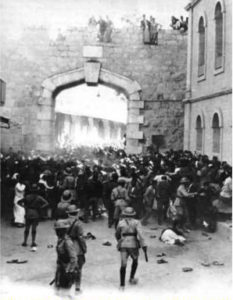August 23, 1929 Arab Murder, Meyhem, and Massacre
No theme is more deeply embedded in Jewish history than exile and return. The biblical exodus from Egypt to the promised land, the return from Babylonian exile, and most recently, the establishment of the state of Israel all affirmed the enduring determination of the Jewish people to return to their homeland.
Yet another wrenching exile and return, now rarely remembered, occurred 80 years ago this week. On Aug. 23-24, 1929, the Jewish community of Hebron was exiled following a horrific pogrom. The tragedy is known as Tarpat, an acronym for its date in the Hebrew calendar.
Until 1929, Jews had lived in Hebron for three millennia. There, according to Jewish tradition, Abraham purchased the care of Machpelah to bury Sarah. It was the first parcel of land owned by the Jewish people in their promised land. Ever since religious Jews revered Hebron as the burial site of their matriarchs and patriarchs. Conquered massacred and expelled over the centuries, Jews always returned to this sacred place.
After 1267, under Muslim rule, no Jews were permitted to pray inside the magnificent enclosure, built by king Herod in the 1st century, that still surrounds the burial caves. But following the expulsion of the Jews from Spain at the end of the 15th century, a small group of religious Jews rebuilt a community of study and prayer in Hebron.
In August 1929, that community was suddenly and brutally attacked. Incited by the Grand Mufti of Jerusalem—who claimed that Jews were endangering Muslim holy sites on the Temple Mount in Jerusalem—Arab rioters swept through Palestine. In Hebron, the carnage was horrendous.
It began on Friday afternoon when Arabs attacked Jews with clubs and murdered a yeshiva student. The next morning, joined by local villagers, Arabs swarmed through Hebron screaming ‘Kill the Jews.’ They broke into the home of Eliezer Dan Sonim, where many Jews had gathered for safety. There they wielded knives and axes to murder 22 innocents. In the Anglo-Palestine Bank, where 23 corpses were discovered, blood covered the tile floor. That day, three children under the age of five were murdered. Teenage girls, their mothers and grandmothers were raped and killed. Rabbis and their students were castrated before they were slain. A surviving yeshiva student recounted that he ‘had seen greater horrors than Dante in hell.’
When the slaughter finally subsided, 67 Jews had been murdered. Three days later, British soldiers evacuated 484 survivors, including 153 children, to Jerusalem. The butchery in Hebron, Zionist and religious officials alleged, was ‘without equal in the history of the country since the destruction of the Temple.’ Sir Walter Shaw, chairman of an exhaustive British royal investigation, concluded that ‘unspeakable atrocities’ had occurred.
Tarpat extinguished the most ancient Jewish community in Palestine. With synagogues destroyed, Jewish property converted into storerooms and barns for livestock, and the ancient cemetery desecrated, few signs remained that there had ever been a Jewish presence in Hebron“
Source: WSJ
